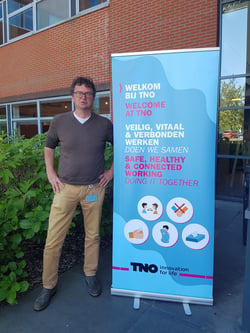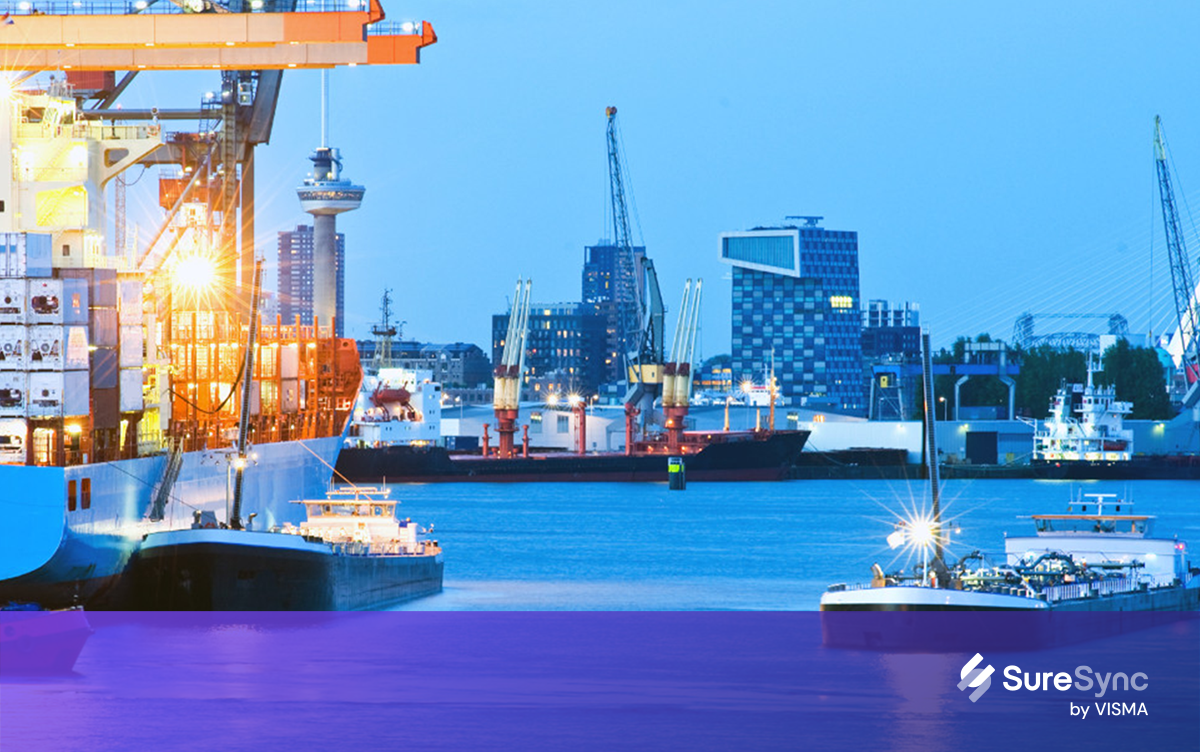Levelling the Playing Field for Data Sharing in Logistics
Levelling the Playing Field for Data Sharing in Logistics: Introducing Bas van Bree and Harrie Bastiaansen, our partners in DASLOGIS
There’s no question that data is today’s most valuable resource. However, how data is used has become a source of concern for citizens and governments around the world. At the same time, not all organisations are equally advanced when using data. At Visma Connect, we specialise in secure and qualified data exchange. We also want to level the playing field so organisations and society at large can participate in this new economy. To achieve this, we participate in many initiatives. In this interview, we speak with two of our partners in DASLOGIS, a consortium that seeks to establish a data space for secure data sharing in logistics. Read the conversation with Bas van Bree and Harrie Bastiaansen below.
Let’s start with Bas. Can you tell us about your current role and activities?
Sure, my name is Bas van Bree. I work at TKI Dinalog as a program manager.  TKI Dinalog is the knowledge institute connected to the Dutch organisation Top Sector Logistics. I’m the program manager for both. I’ve worked here for 6 years now. Before joining TKI Dinalog, I worked at a business consulting firm dedicated to transport and logistics. In that role, I worked on control tower environments for logistics service providers and shippers.
TKI Dinalog is the knowledge institute connected to the Dutch organisation Top Sector Logistics. I’m the program manager for both. I’ve worked here for 6 years now. Before joining TKI Dinalog, I worked at a business consulting firm dedicated to transport and logistics. In that role, I worked on control tower environments for logistics service providers and shippers.
Harrie, what about you? Can you tell us about your background and your work at TNO?
 I am Harrie Bastiaansen. I have a background in telecommunications. In the past, I worked for KPN and KPN research, so I have a lot of experience building telecommunications infrastructures. I joined TNO 15 years ago. TNO is the Netherlands Organisation for Applied Scientific Research. About 3 years ago, I started working on several data-sharing projects within TNO. Developing large-scale data-sharing infrastructures is my focus at the moment. We have data-sharing projects in many sectors, including logistics. A big part of our work encompasses implementing data sharing across sectors so we don’t end up with silos.
I am Harrie Bastiaansen. I have a background in telecommunications. In the past, I worked for KPN and KPN research, so I have a lot of experience building telecommunications infrastructures. I joined TNO 15 years ago. TNO is the Netherlands Organisation for Applied Scientific Research. About 3 years ago, I started working on several data-sharing projects within TNO. Developing large-scale data-sharing infrastructures is my focus at the moment. We have data-sharing projects in many sectors, including logistics. A big part of our work encompasses implementing data sharing across sectors so we don’t end up with silos.
That’s interesting that you bring up the issue of silos. Many of our readers will recognise what it’s like to work at a company where data is kept in silos, but you also hear more about data lakes and data sharing nowadays.
What do you want to achieve in your current roles?
Harrie: My and my department’s ambition at TNO is to make the European data strategy work. This strategy is now being defined, and we want to make it more concrete across countries and sectors. A key question we face is how we will do this and implement it across countries. Logistics is a big part of the European community, so it’s a key focus area for us.
Bas: Our ambition at TKI Dinalog is to prepare the Dutch logistics sector for the future. We fund research projects, focusing on the medium or longer term. Our umbrella organisation, Top Sector Logistics, identifies current trends and new developments and tries to make them applicable in the short term if possible. We help companies active in the logistics sector become more innovative to achieve their goals. These can be efficiency or sustainability goals, for instance. Harrie also mentioned the European data strategy; as TKI Dinalog, we strive to make it specifically applicable in the logistics sector.
Can you tell us more about the European data strategy?
Harrie: Let’s start with the reason behind it. The European Union recognises that data is the new fuel for society. We need it for all kinds of things. However, it’s largely under the control of big companies. The biggest companies in the world have become IT companies in the last 10 years. These companies are mainly based in the U.S. and Asia. They excel at gathering data and have become the focal point for data gathering and sharing. But this is not always good.
The European data strategy aims to make data available to fuel the emerging data economy but does it in such a way that we keep control over the data. Data sovereignty is quite an important aspect of the European data strategy. The data owner should remain in control of the data. This means we need to prevent our data from ending up under the control of American or Asian companies and systems. If I may summarise, its two main objectives are to make data available and to make it available according to the European values of data sovereignty and control. The EU is quite active in defining this strategy, and they have published a Data Governance Act. In the past few days, they released the design principles for this data strategy, including the application of data spaces.
What are data spaces?
Harrie: Data spaces are communities in which data is shared according to these European values, in a way that will be made interoperable with other data spaces as well. Data spaces ensure sovereignty, keeping data at the source.
How are they connected to initiatives like GAIA-X and the International Data Spaces Association (IDSA)?
Harrie: IDSA is an organisation with European roots that has developed a standard for secure data exchange. The IDSA standard governs international data spaces (IDS) and are at the core of the application of the European data strategy. The IDSA standard enables data exchange through these data spaces, using uniform rules and architectural principles, certified data providers, and facilitating trust between the organisations active in the data space.
While IDSA offers the standard, GAIA-X is the infrastructure for secure data exchange - a European cloud. GAIA-X is a project that will connect existing cloud services and spark innovative new modes of connectivity. The goal is to create a federated digital infrastructure for Europe. It’s not about building data centres but how you deploy your processing tasks and whether these data centres can provide control over where the data is going.
How do these developments affect or shape how data is shared in logistics?
Bas: Data sharing in the logistics sector is obviously not new. What the logistics sector has always done is work in a chain, implying that you need to share data in one way or another. But today, we must recognise these new developments and see how they will affect the logistics sector.
To investigate this, we set up DASLOGIS as a project in collaboration with TNO. The goal is to understand International Data Spaces and see how they should be applied in a proof of concept setting by creating a data space for the Dutch logistics sector. We want to understand what it implies for new and current roles.
What do you mean by new roles? For instance, 20 years ago, a role like a control tower probably would not exist because everything was paper-based. Is that what you mean?
Bas: Yes, that’s a good example. In a control tower setting, we try to get visibility on where assets are, what type of orders are coming in and so on. It’s a type of dashboard to make decision support as easy as possible. We are now moving towards data sharing throughout a chain, system to system and between companies. This implies that roles like a control tower could be re-defined based on the new way we share data. It may also affect other roles. For instance, should shippers organise transport themselves or should a centralised entity arrange it? With DASLOGIS, we are looking at how these roles will be shaped in the logistics industry through new data-sharing frameworks.
Today, logistics companies also need to think a lot about sustainability. You have new regulations that require carbon emissions reporting, for example.
Bas: We anticipate this will be implemented at a European level. Logistics service providers must disclose their footprint and account for their achievements. New legislation is also coming up at a European level, which makes companies responsible for how they steer their chain. This will make them accountable for their socio-economic impact. Data sharing will help them provide the required information for these new regulations, but also for internal purposes. Defining how we share data within the logistics sector is key to preparing for this near and longer-term future.
We have seen lots of innovation in logistics the last few years. For example platooning projects and a data sharing initiative like iSHARE. Can you talk more about this?
Bas: Platooning is just one example of the innovations that the logistics sector is facing. Platooning is a technical development in itself; trucks drive close together in small convoys to improve traffic flow and traffic safety. What we are interested in is seeing how this type of developments affect the way we organise as a sector - in the Netherlands and in a world-wide setting.
This is also a data sharing and telecom infrastructure question, isn’t it Harrie?
Harrie: Yes, it’s partially about telecommunications. The challenge here is that data models are sector-specific, which makes them less applicable outside the original domain. We need to have standards for data sharing, so that these innovations can be implemented more easily.
When we started working on data spaces, we found some documents from AT&T, dated in the mid-90s, that more or less describe how data spaces could work internationally. The concept was developed there, but something happened in between the telecom market liberalisation. This made it quite difficult to agree on standards for sharing data. Each provider had their means to develop their infrastructure. Data sharing was left to the market, and each party wanted to dominate certain aspects, building their own solution. They did not think about interoperability. Forced by new conditions and the European data strategy, we are now considering moving towards standardisation again.
Going back to logistics, would you say the industry is innovative and what are the main challenges it faces today? For instance, you hear a lot about congestion and an aging workforce.
Bas: I would say the sector is not as innovative as we would like, but there are very innovative frontrunners. The problem is getting the laggards up to speed, so we can safeguard their future. If the frontrunners advance a lot and their subcontractors cannot cope with new developments, the digitisation gap will only increase. For the sector to work effectively, it needs to be interoperable. Interoperability between SMEs and their large clients is a key concern and challenge. Data spaces can help us work towards that. Congestion is also a problem, but the shift to a more sustainable supply chain is an even larger challenge currently.
Do you foresee major technological innovations like hyperloop or driverless trucks impacting the logistics industry?
Bas: The hyperloop is an example of a technological development that will not be available for logistics in the next 5-10 years. A lot of things need to happen before this becomes a new modality. We need to monitor what’s happening with initiatives like driverless trucks or the hyperloop to see how they could help or affect the sector. However, I think the way we apply data is more significant in the short-term compared to the application of driverless trucks. For example, how artificial intelligence capabilities can help us improve productivity and efficiency is something we should be looking at more closely today.
Speaking of data, Visma Connect is part of the consortium working on the DASLOGIS project (Development and valorization of a Dutch Data Space for logistics), which you are also a part of. We spoke about DASLOGIS briefly. The project seeks to create a digital environment or ecosystem that enables the discovery and controlled sharing of (potentially) sensitive data.
Why do you need a consortium of companies to achieve this?
Harrie: DASLOGIS focuses on building a data space for logistics. The project includes partners that operate outside of logistics itself. For instance, partners that enable the infrastructure to run. You need parties that will fulfill an intermediary role to make the data space work. These parties include identity providers and vendors that offer security gateways, authorizations, and more functionalities that are deployed on a large scale. For instance, Visma Connect is enabling data sharing with these kinds of functionalities. We need several of these enabling parties to run the infrastructure. You would also like some representative use cases, to demonstrate what you could do with this. So, logistics companies that have data sharing needs are also a part of the consortium.
Furthermore, there are partners that would like to interact with the data sharing infrastructure for logistics. For instance, Dexes. They are building the trust infrastructure for DASLOGIS and the Amsterdam Data Exchange (AMdex). Gaining access to logistics data sources is key for them. They would like to make AMdex interoperable with the data spaces for the logistics sector.
So, there are different roles for different topics: building a data space, being interoperable, and leveraging the space as users in logistics. This broad spectrum of partners doesn’t make the project easy to run, but the advantage is that you cover all aspects that you would like to cover in such a data space.
Why build a data space for logistics specifically?
Bas: We are looking at how a dataspace could be organised in the logistics sector, but as Harrie mentioned, the project encompasses many partners outside of logistics as well. Why logistics specifically? The sector supports almost all industries in our economy, so interoperability between the logistics space and others is essential. It will be key for running the sector in the future.
Harrie: To add to Bas’ comment, we are also building a data space for the smart industry network in Eindhoven. There are already 200 organisations connected. They also have logistics and transport needs. So we cannot think of DASLOGIS as an isolated project. Logistics doesn’t stop at the Dutch border. There are also big initiatives to build data spaces for logistics and mobility in Germany, for instance. Interoperability between sectors and countries will benefit not only the Dutch logistics industry, but for sectors in other countries as well.
Can you offer examples of how a dataspace can help companies?
Harrie: The essence of a data space is regaining control over who gets what data, and for what kind of purpose. One of the main advantages of data spaces is that they open up the possibility to share data that organisations would previously not share, because it was too sensitive. Following the principles laid out in IDSA, you regain control and have clear agreements about the use of data. Let’s take the data space for logistics and the data space for smart industry as an example. You can think of logistics companies getting access to the loading docks at smart industry manufacturers. By exchanging the data through these secure data spaces, you can provide access to the facilities in a secure and controlled way.
Bas: There are indeed many use cases for logistics. In the past, the problem we faced with data sharing initiatives was the lack of trust. For instance, data on truck loads is quite sensitive and organisations have traditionally been unwilling to disclose it. Companies involved in a supply chain don’t always trust each other. By participating in data space with pre-defined agreements, they can gain that trust.
Harrie: You can also see applications, where for instance, instead of sharing the data outright, you share the results of an algorithm.
Bas, you are the programme manager for Cross Chain Control Centers (4C) at TKI Dinalog. What is a Cross Chain Control Center and what are the applications for data sharing there?
Bas: 4C is a concept that was developed 10 years ago. It assumes that if you are able to reorganise the flow of goods within and across supply chains, you’ll have more opportunities to make them more efficient. For instance, if you have company A, which undertakes shipments in several lanes throughout Europe, and you add the lanes of company B, which performs the same task, then you have a larger pool of routes and shipments which you can organise in a more optimal way. If you oversee a lot of lanes in a central control tower, you might be able to bundle shipments to make the supply chains more efficient. You may find that you’re better off using rail or barge for a large bundled shipment, instead of multiple trucks. The concept can be applied in many different settings, and as you can imagine, data sharing is key to make it work effectively.
How does the TKI Dinalog control center differ from commercial ones?
A traditional control tower organises flows for a particular assignment. For instance, a shipper moves from A to B, and a contract with a logistics service provider organises that specific flow. A cross-chain, by contrast, tries to gather all flows and see if they can be organised in a more efficient way, agnostic of commercial agreements or not. That’s how a cross-chain control tower differs from a traditional one.
I want to close with a quote from our Managing Director, Kim Andersen: “Effective data sharing requires a more democratic way of data sharing. This comes with diminishing the power of bigger companies by creating a level playing field that makes the barrier for many organisations and even individuals to share their data much lower.”
What is your opinion on this subject?
Harrie: I agree and it’s aligned with the goals of the European data strategy, which seeks to give individual data providers control back over their data. It’s a good way to shift power from big businesses to data owners. By providing functionality for data sovereignty, we will also lower the barriers for others to enter the data economy.


